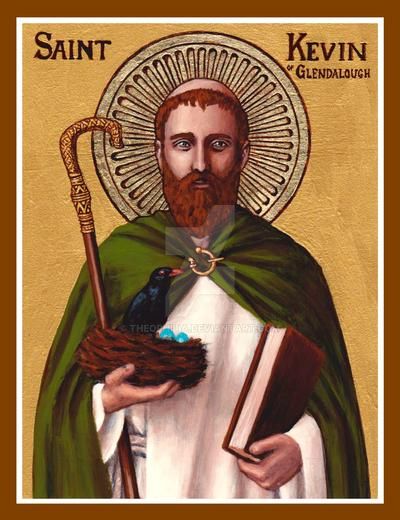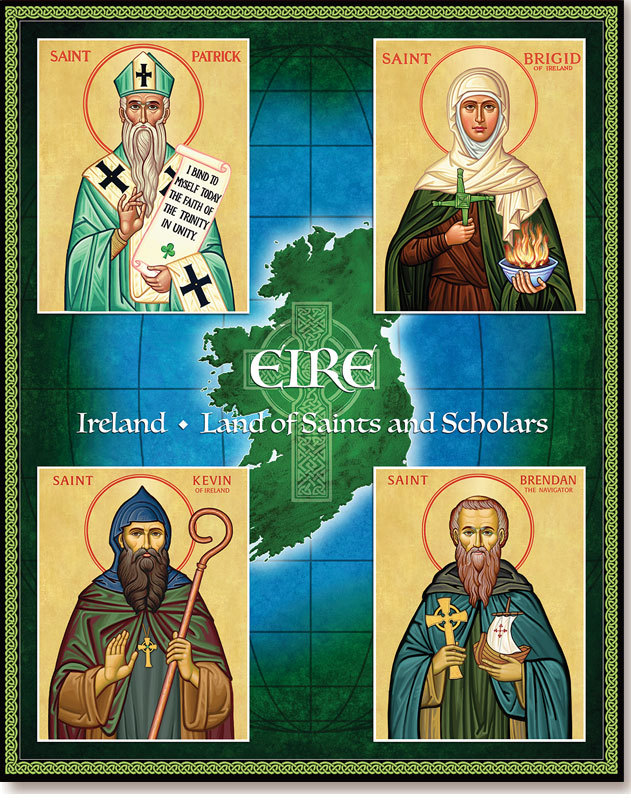
Image Source: PopeHistory.com
The article below was distilled from St Kevin of Glendalough
The sources for St. Kevin’s story are the Codex Kilkenniensis in Marsh’s Library in Dublin which has three Latin Lives and also three Irish Lives transcribed by Michael O’Clery in 1629 from the old books that narrate oral traditions.
Kevin is the first person in history to carry such a name. He was also the fulfilment of the prophecy of St. Patrick. For Kevin was foretold by Patrick to come to evangelize the region south of Dublin. He was canonised informally by Cultus confirmation in the beginning of the twentieth century.
Now Kevin was born around 498, of good looking parents judging by their names. Kevin and his parents were in a phrase, ”the comely family”. Here is how we can demonstrate it, reinforced by tradition, in which we can know many things about St. Kevin. We take our sources of course from transcriptions from extant Latin texts.
The name Kevin is the anglicised version of Caoimhín, which is modern Irish derived from Coemgen which are two joined words like a double barrel name; meaning comely generated or pulcher-genitus; which means fair-begotten. Phonetically coem sounds a bit like comely. Gen is the root for generated. Tradition tells us that an angel appeared before the child was baptised and gave him the name Coemgen. Now Kevin’s father was already called Coemlug, and Kevin’s mother was called Coemell. So without known the full meaning of their names we get a glimpse that putting the three names together, they were ”a comely family”. This is an opinion, based on deduction from a foundation that offers a reasonable degree of plausibility.
Tradition confirms that Kevin was considered handsome, as it regales a story about him in formation to be a priest. At the monastery of Kilmanagh, Kevin unconsciously won the heart of a certain lady called Kathleen! So the story goes that Kathleen saw the handsome Kevin in a field with his fellow monks working away. She was instantly infatuated by him and followed him into the woods, when he was alone. She desired his heart and yearned for his embrace. Though Kevin was tempted… he threw himself into a bed of nettles. This did not deter the sweetheart Kathleen from making advances on him, so he had to resort to draconian tactics. He lit a fire from dried leaves, and flung it at her to dispel her advances. Kevin acted like an impassioned man fighting fire with fire. In the end the comely Kathleen got the message and better than a perfect romance novel, she became a nun and gave her heart totally for Christ.
From the Monastery of Kilmanagh, Kevin while in formation, skived off duties for a while. He loved the nature and a holy angel guided him to Glendalough and straight to a cave which was to become known as St. Kevin’s bed. He was found out later, after a straying cow came nearby and began to give quantities of milk in a miraculous way. The owner of the cow brought Kevin’s whereabouts to light, and Kevin’s professors from the Kilmanagh monastery, came to retrieve the lad from his solitude. His three professors were St. Eonaghan, St. Petroc of Cornwall and Kevin’s uncle, St. Eugenius.
A story from his period of formation at Kilnamanagh shows kevin as an extraordinary monk. One day Kevin forgot to prepare small fire from another large fire, in view of lighting the candles for Mass. He was told to ‘run quickly to the [source] fire to get those candles burning’. Kevin was hesitant and asked, ‘How will I carry it? You’ll carry it ‘in your bosom,’ was the reply. So Kevin went and collected the fire in a garment waist around him. Miraculously, neither his clothes nor his flesh was burned. The older monk, recognising this, full of remorse, remarked, ‘O holy youth, I see that you are full of the Holy Spirit.’
Kevin was ordained by Bishop Lugidus and following his ordination, he established his initial monastery, now lost in time & space. A most interesting tradition regarding Kevin’s next foundation is about a pet goose which belonged to King O’Toole of Glendalough. Both the king and the goose were becoming frail with time, and the goose was by now unable to fly. The King heard of Kevin’s sanctity and power, and sent for him, seeking a miracle. He wished his beloved goose to be young and agile. Kevin gave his price, namely; whatever land the goose would fly over was to be granted to Kevin. King O’Toole thought little of the price, not believing his goose would fly at all. When Kevin healed the bird, it grew firm, and flew over the entire valley of Glendalough. With such extensive lands, Kevin founded the monastery of Glendalough.
In Glendalough, Kevin initially lived an ascetical life in solitude. He lived near the upper lake, in that narrow cave called ‘St Kevin’s Bed’. In the solitude “the branches and leaves of the trees sometimes sang sweet songs to him, and heavenly music alleviated the severity of his life.”
His ascetical life was severe… He wore wild animal skins and ate whatever food growing on the surrounding trees and plants. He slept on a stone slab with a smaller stone for a pillow. For further penance he recited the psalms standing in cold waters, which is a common penitential practice for Irish monks. One time Kevin dropped his psalm book in the lake, but it was retrieved undamaged and dry by an otter.
Kevin established a hermitage near his cave at the upper lake at Templenaskellig, and divided his time between his hermitage and a growing community of followers below at the lower lake. As an abbot he founded a monastic centre. So numerous were his disciples, that Glendalough became a veritable city. Glendalough became an episcopal see, but was later incorporated with Dublin diocese. In all seven Churches of Glendalough have for established within the monastic city. The monastery enjoys pilgrim status with plenary indulgence, and several trips to Glendalough is equivalent to one trip to Rome.
Another good story is about Kevin working in Kevin’s kitchen to help pilgrims who were hungry. He told his attendants to fill the ale jars with water and gather together the bare meat bones. Praying over the water and bones, he changed the elements to ale and meat, to everyone’s satisfaction.
St. Kevin had a special love for birds and animals. The “Acta Sanctorum” is based on an ancient manuscript contains a number of traditions. The afore mentioned otter was to be a great help mate to Kevin, bringing him fish each day. Such was the effect Kevin had on nature. For the animals were without fear in his presence. The otter only fled much later on in life, as the community grew and one of the newer monks considered it good for game.
Before his death, Kevin remained permanently at his hermitage near the upper lough. His monks were requested not to bring him food, nor help, nor disturbance in any way. For Kevin enjoyed the company of the wild animals. One day, a wild boar, being hunted for game, cowered its way towards Kevin, in the woods. The hunting dogs and their masters where in hot pursuit. The hounds lay down on seeing St. Kevin, and ceased to go after the boar. The hunters willed to kill their prey, but for a flock of birds settling in the tree above the praying saint. They took this as a sign from God, and left saint and beast alone.
St. Kevin died in his hermitage soon after. The Annals of Ulster mention the year of his death as 618. That’s 120 years of life granted to the Irish Saint.
